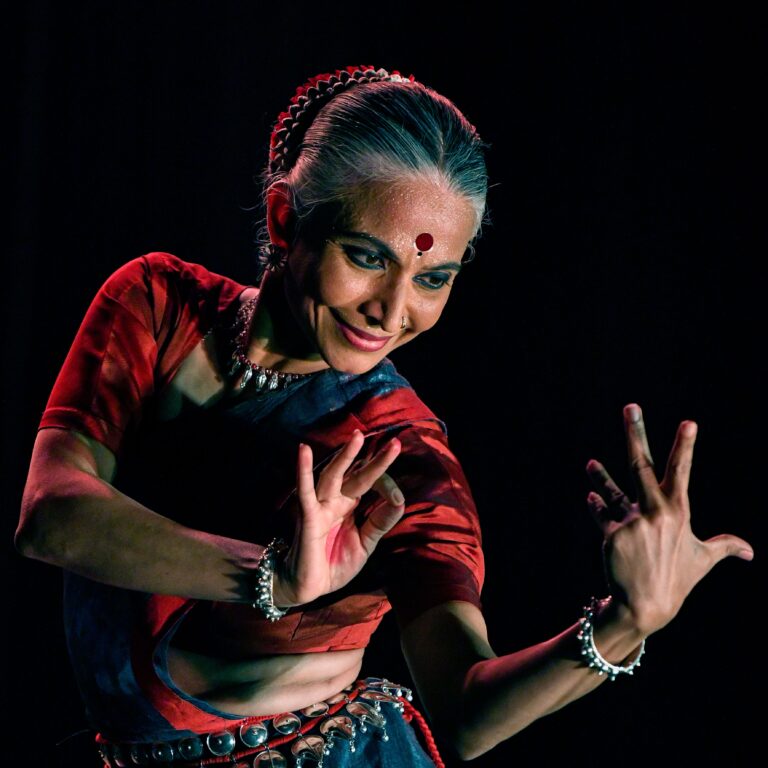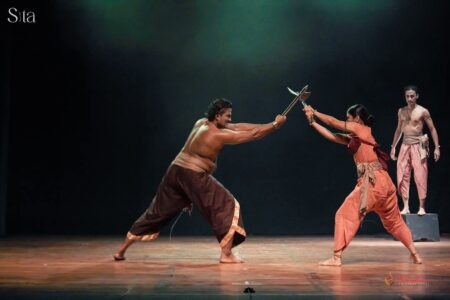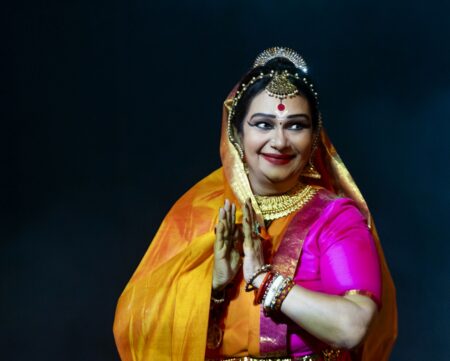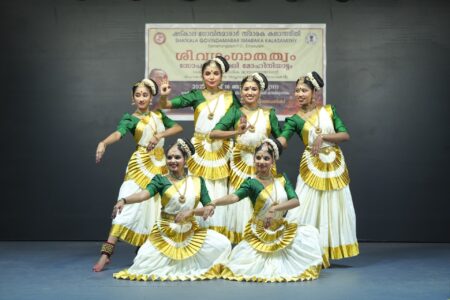The skill and technique of the various dance forms are imbued with memories of past times, specific history and cultural ethos, says Odissi dancer and teacher Bijayini Satpathy.
Odissi is one of the dances that finds mention in the Natya Sastra and hails from the eastern Indian state Odisha. Known for its graceful ‘tribangha’ or the tri-bent format, Odissi’s leading patrons have dedicated a lifetime to developing the dance form. Bijayini Satpathy is one of the talented Odissi artistes who is finding new ways to put the spotlight on different aspects of Odissi.
The singular devotion with which she has charted her path to carve a name in Odissi is commendable. Satpathy joined Bengaluru’s dance school Nrityagram in 1993 when its founder Protima Bedi selected her to join the school and Nrityagram’s performing dance troupe. In 1997, she became a solo debutant and continued to study and perfect Odissi at Nrityagram. For 25 years, she donned several roles at Nrityagram as a Principal Dancer, performer, teacher, research scholar and administrator – 20 of which she spent as Director of Training – until 2018 when she decided to pursue further research and solo work outside of the ensemble.
Satpathy is keenly exploring her own choreographic path and has been spending time as the artist-in-residence with the Metropolitan Museum for the 2021-22 season. In December 2021, she premiered her first choreographed work ‘Abhipsaa: A Seeking’ commissioned by Duke Performances (Duke University, North Carolina) and Baryshnikov Arts Center (New York) with additional support from NEFA’s National Dance Project.
In an e-mail interview with India Art Review’s Sanjitha Rao Chaini, dancer Bijayini Satpathy talks about her journey into dance, the contemporary vocabulary of Odissi, loss and grief she went through in 2020, and her expedition in dance in the US. Excerpts:
What is Abhipsaa?
‘Abhipsaa: A Seeking’ is my first choreographic commission and production. It consists of a combination of narrative (nritya and natya) and non-narrative (nritta) dances, in which I explore the idea of seeking in physical, emotional and spiritual realms while expanding the parameters of the formal and representational norms of the Odissi tradition.
Duke Performances at Duke University, North Carolina and Baryshnikov Arts Center, New York are the lead commissioners of Abhipsaa. Additional support was made possible by the National Dance Project supported by New England Foundation for the Arts, with lead funding from the Doris Duke Charitable Foundation and The Andrew W. Mellon Foundation.
I created Abhipsaa during the Covid-19 pandemic. While direct interaction with music collaborators became impossible, I was fortunate to have two excellent musician brothers in my safe bubble – one a superb flautist, music lecturer and composer, and the other a percussionist of Odissi Mardala. Most of our creative process took place during our father’s illness, passing and grief through 2020. He was our biggest and most important artistic inspiration and support. On 10 and 11 December 2021, the World Premiere of Abhipsaa was presented at the Rubenstein Arts Centre, Duke Performances, Durham.
The dances of Abhipsaa are Vibhanga, Virahi and Vimukthi. Vibhanga is set to Desh Thillana composed by the legendary violinist Lalgudi Jayaraman, unfamiliar to the music flavour of Odissi. I have explored the response of Odissi to this Thillana in which I feel Odissi instinct took me to newer realms of form, space and design.
In Vrahi, in longing, I have explored the Gita Govinda (composed by 12th century poet Jayadeva) songs of love and longing, which form the heart and soul of Odissi dance. Based on one of the songs, I explore emotional seeking between lovers, separated, in longing for each other and the delicate role and state of mind of the messenger between them.
In Vimukthi, the final dance, I have tried to explore the idea of formless divinity. Claimed equally as a Hindu and a Muslim, the mystic poet Kabir sings of Nirgun, a formless God. Kabir celebrates death as the final dance when the soul breaks free from the structures and conformities of life. I find ways to express the ideas of ecstasy of the spirit and the formless divinity in this.
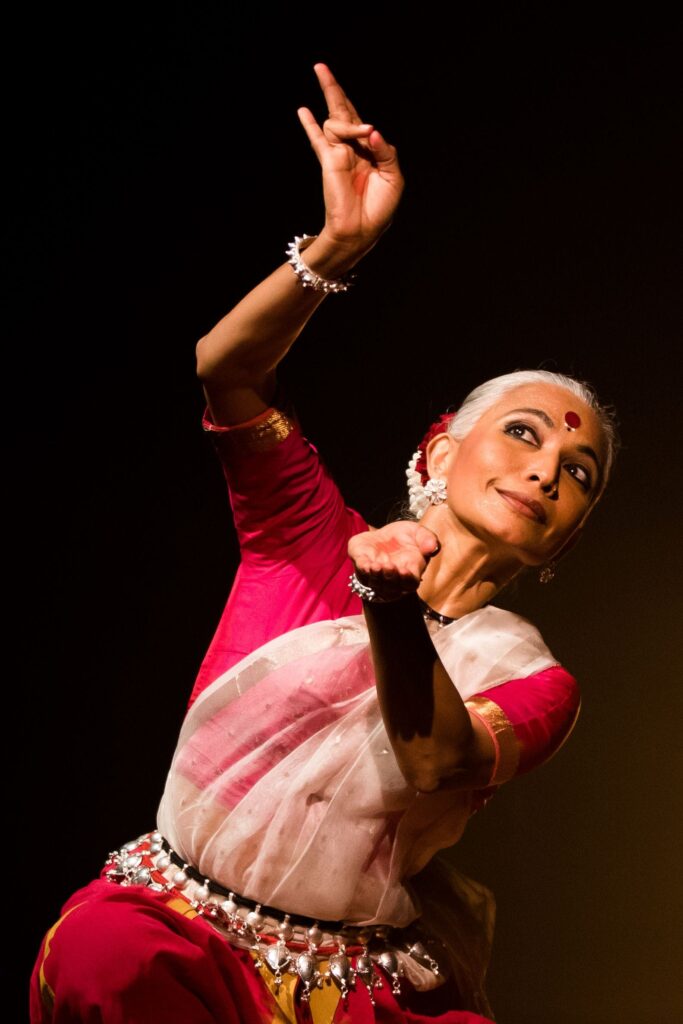
Photo credit: Shalini Jain
We would like to know more about your choreography journey…
I was entrusted with a lot of belief from highly respectable artists, arts presenters and arts organisations to choreograph from the get-go. That meant a lot and that also made me stronger in my belief in myself as a choreographer. The task of creating has led me to new findings in Odissi. I have created three full-length choreographic works in the last two years. Abhipsaa, a seeking, and Call of Dawn with solo original works and Pranati, an obeisance, a reimagined duet production based on traditional works by Guru Kelucharan Mohapatra.
At the moment, I am creating space-specific works for four galleries in the Metropolitan Museum (New York) as the artist in residence 2021-22. Each of these works reveals to me deeper, intricate, essential structural and design truths about Odissi, and teach me about my instincts in the here and now.
How has Odissi evolved as a dance art form? Where does it stand now?
It has been proven by evidence that dance has existed for 2,000 years in the land of Orissa and around. We don’t know a whole lot about Odissi before its revival less than a century ago. We have tried to follow the visible threads and cues from the existing traditional dances, the temple sculptures, from the senior temple dancers and from the local folkloric movement traditions to reinvent and create a fresh understanding of Odissi.
I believe we have made up a lot with our present, modern sensibility and that makes Odissi vocabulary contemporary. Every serious practitioner of this tradition has embodied it and is passing it on with their own flavour and interpretation. Therefore, it is exciting to see rapidly expanding technique and presentational content in every way. The elasticity that the form allows makes it contemporary.
What and who are the key influences in your life in dance?
My parents instilled in me a love for music and dance. The Institute of Integral Education in Bhubaneswar, where I studied dance, made me value dance as an important extension of self. Orissa Dance Academy, also based in Bhubaneswar and founded by Guru Gangadhar Pradhan gave me a strong technical foundation and practice discipline. At Nrityagram, through 25 years of collaboration with Surupa Sen, I found my personal equation and relationship with Odissi. Gaurima (Protima Bedi) made me believe in myself as a dancer. Every teacher I have learnt with and continue to learn with is a contributor to my dance in a very meaningful way.
You left Nrityagram in 2019. Where has that taken you as a dancer?
I studied, performed, taught, researched Odissi dance for a quarter of a century at Nrityagram. For all new productions, I collaborated as the resource person for text and lyrics and the design of costumes. As the director of training, I structured all the training programs and curriculum. I started expanding the training vocabulary of Odissi and created a method to prepare the body for an injury-free optimum performance career. Everything I did there naturally serves as the foundation for everything I do now.
My work now is a continuation of that study and research. I also choreograph now and largely on myself. I have begun to discover that Odissi is more elastic than I have known. I find new ways of inner and external Odissi movements and designs, and I see myself being drawn to the essential Odissi rather than the normative. It is a very young journey to analyze yet. I am very excited about my current residency at the Metropolitan Museum for which I am creating works for four gallery spaces.
What are a few goals every dancer should pursue while learning dance?
Goals can be different, be it performer, teacher, choreographer, scholar. But some of the processes will have to be the same for dance, an embodied practice. Dance must be embodied to the point it becomes second nature, a default natural and organic mode of being.
The body is the root and medium of an embodied practice and therefore, it must be prepared, cared for and disciplined, first and continuously. The skill and technique of the various dance forms are imbued with memories of past times, specific history and cultural ethos. To eliminate the separateness between those memories and the contemporary body and to find the essence of the form is to practice repeatedly, in the body.
I look for signs of a certain lingering restlessness and agitation and that I feel is the reminder that it’s time to return to wonder from comfort and habits. It is important to remain vigilant of our state of mind from time to time and take note of such thresholds. Wonderful things can happen from there.
What is next on your agenda?
I will continue to do what I do – practice, perform, research, teach, choreograph, write, collaborate…
Write to us at [email protected]

